Journal of Modern Physics
Vol.3 No.9A(2012), Article ID:23123,3 pages DOI:10.4236/jmp.2012.329169
General Relation Connecting the Fundamental Fields
1Singhania University, Jhunjhunu, India
2Department of Electronics, Vidyasagar University, Midnapore, West Bengal, India
Email: *mukuldas.100@gmail.com
Received June 3, 2012; revised July 18, 2012; accepted July 25, 2012
Keywords: Fundamental Force; Unified Field; Generalized Relation
ABSTRACT
There are four fundamental forces: gravitational force, electromagnetic force, strong force and weak force, in the well known physics. The unified field theory considers the constructive relations among these forces or fields. In the present work the fundamental relations have been studied and trial has been made to derive more significant relations among the known fields. This gives out a generalized unification.
1. Introduction
According to Newton’s law, two bodies of mass  and
and  attract one another with gravitational force whose magnitude is
attract one another with gravitational force whose magnitude is . But Einstein’s general relativity does not consider gravity as a force rather it is a space-time curvature. As in [1] Newtonian field equation is
. But Einstein’s general relativity does not consider gravity as a force rather it is a space-time curvature. As in [1] Newtonian field equation is , but in general relativity the Einstein equation is
, but in general relativity the Einstein equation is . On the other hand Maxwell equations [2] are the field equations of electromagnetism that relate the electromagnetic field to its source-charge and current. But Einstein’s equation relates the space-time curvature to its sourcethe mass-energy of matter. The well known unified electromagnetic field Equations [2] are
. On the other hand Maxwell equations [2] are the field equations of electromagnetism that relate the electromagnetic field to its source-charge and current. But Einstein’s equation relates the space-time curvature to its sourcethe mass-energy of matter. The well known unified electromagnetic field Equations [2] are  and
and
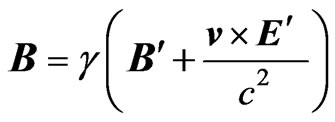 . These imply that one observer’s electric field is another’s magnetic field and that depends on the relativity. In 1935, H. Yukawa proposed a theory on generation of strong force [3] which deals with particle physics. This theory implies a relation between electromagnetic field and strong field. After a long year of this contribution, the weak force and the electromagnetic force were unified in a theory presented independently by A. Salam, Weinberg and Glashow [4-6]. Afterwards a lot of papers, regarding unified field theory, have been published. However, in [7,8], trial have been made to deduce relations among the known fields (i.e. gravitational field, electromagnetic field, strong field) following a constructive method, which may satisfy the dream of Einstein’s fields unification. The present work is the modified formulation of unified field equations as discussed in [7,8].
. These imply that one observer’s electric field is another’s magnetic field and that depends on the relativity. In 1935, H. Yukawa proposed a theory on generation of strong force [3] which deals with particle physics. This theory implies a relation between electromagnetic field and strong field. After a long year of this contribution, the weak force and the electromagnetic force were unified in a theory presented independently by A. Salam, Weinberg and Glashow [4-6]. Afterwards a lot of papers, regarding unified field theory, have been published. However, in [7,8], trial have been made to deduce relations among the known fields (i.e. gravitational field, electromagnetic field, strong field) following a constructive method, which may satisfy the dream of Einstein’s fields unification. The present work is the modified formulation of unified field equations as discussed in [7,8].
2. Modified Relation among the Fields
The well known relations between electric field and magnetic field are
 (1)
(1)
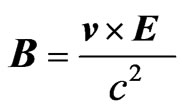 (2)
(2)
From (1) and (2) we shall have the matrix form of these field transformation as
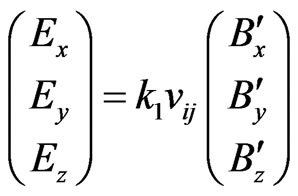 (3)
(3)
 (4)
(4)
where ,
,  are two constants. Again, we would obtain from relativistic electrodynamics [2] the relations
are two constants. Again, we would obtain from relativistic electrodynamics [2] the relations
 (5)
(5)
 (6)
(6)
where,  is the proper velocity. So, using (3) and (4) we get from (5) and (6)
is the proper velocity. So, using (3) and (4) we get from (5) and (6)
 (7)
(7)
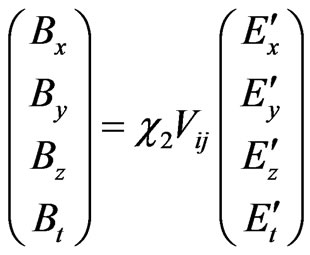 (8)
(8)
 are also two constants.
are also two constants.
where, 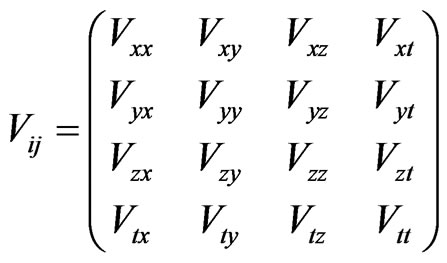
But,  are not separate. These are included in a field which is called electromagnetic field. According to [9,10] electromagnetic field function
are not separate. These are included in a field which is called electromagnetic field. According to [9,10] electromagnetic field function . So, from (7) and (8) we get a generalized relation
. So, from (7) and (8) we get a generalized relation
 (9)
(9)
where, 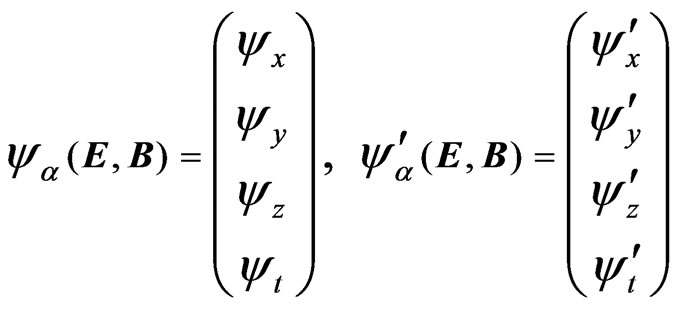
This means that transfer to
transfer to respectively in
respectively in . In [7] it reveals that through two simultaneous superimposed motions gravitational field transfers to electromagnetic field and the relation is
. In [7] it reveals that through two simultaneous superimposed motions gravitational field transfers to electromagnetic field and the relation is
 (10)
(10)
where ,
, 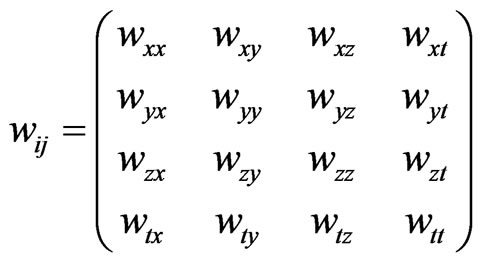 , and
, and
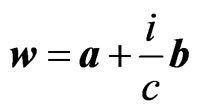 as in [7]. Again in [8] relation between strong field and electromagnetic field is given by
as in [7]. Again in [8] relation between strong field and electromagnetic field is given by
 (11)
(11)
This leads to a relation between strong gravitational field (strong field) and weak gravitational field  which is
which is
 (12)
(12)
Equations (7), (8), (10) and (11) are analogous. So, following (5) and (6) we can write the relations in vectorial form as
 (13)
(13)
 (14)
(14)
where,  in (13) represents weak gravitational field and
in (13) represents weak gravitational field and  in (14) represents strong gravitational field or strong field.
in (14) represents strong gravitational field or strong field.  is the composed velocity as in [7] as well as four-velocity. In (13) and (14)
is the composed velocity as in [7] as well as four-velocity. In (13) and (14)  are two constants.
are two constants.
Again from (12), (13) and (14) we can consider the vector relation between strong field and weak gravitational field which would give
 (15)
(15)
where,  is a constant like
is a constant like  and
and 
3. Conclusion
In this work a constructive vector relation among the fields has been deduced. Equations (13)-(15) represent such relations which can clear the concepts of fields transformations. These also imply that field transformations are associated with relativistic phenomenon in different frames.
4. Acknowledgements
Author thanks the authorities and staff of Satmile High School, Satmile-721452, West Bengal, India for their continuous encouragements.
REFERENCES
- J. B. Hartle, “Gravity. An Introduction to Einstein’s General Relativity,” 3rd Edition, Pearson Education Inc., India, 2009, p. 510.
- D. J. Griffiths, “Introduction to Electrodynamics,” 7th Edition, Pearson Education Inc., India, 2009, pp. 549-550.
- S. N. Ghoshal, “Nuclear Physics,” S. Chand & Company Limited, New Delhi, 2006, pp. 365-430, 881-889.
- L. Glashow, “Towards a Unified Theory: Threads in a Tapestry,” Reviews of Modern Physics, Vol. 52, No. 3, 1980, pp. 539-543. HUdoi:10.1103/RevModPhys.52.539U
- A. Salam, “Gauge Unification of Fundamental Force,” Reviews of Modern Physics, Vol. 52, No. 3, 1980, pp. 525-538. HUdoi:10.1103/RevModPhys.52.525U
- S. Weinberg, “Conceptual Foundations of the Unified Theory of Weak and Electromagnetic Interaction,” Reviews of Modern Physics, Vol. 52, No. 3, 1980, pp. 515- 523. HUdoi:10.1103/RevModPhys.52.515UH
- M. C. Das and R. Misra, “Fundamental Way of Charge Formation and Relation between Electromagnetic Field and Gravitational Field,” International Journal of Astronomy and Astrophysics, Vol. 2, No. 2, 2012, pp. 97- 100.
- M. C. Das and R. Misra, “A Short Note on Alternative Strong Force,” International Journal of Astronomy and Astrophysics, Vol. 2, No. 2, 2012, pp. 74-75.
- I. I. Popescu, P. Sterian and M. Dobre, “The Photon Wave Function and the Fresnel Formulas,” Romanian Reports in Physics, Vol. 62, No. 2, 2010, pp. 360-368.
- R. E. Nistor, “Quantum Aspects of Photon Propagation in Transparent Infinite Homogeneous Media,” Romanian Reports in Physics, Vol. 60, No. 3, 2008, pp. 471-491.
NOTES
*Corresponding author.

